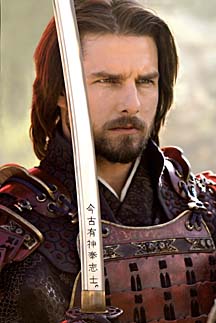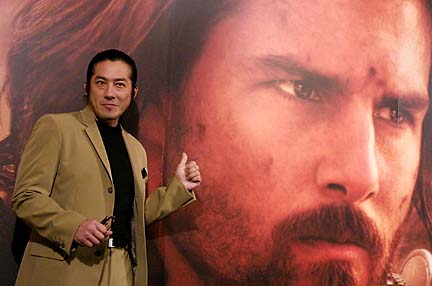
‘Samurai’ slices
through historyTom Cruise’s new film
offers a glimpse of life lived
by an ancient code of honor
My American friends often ask two questions about the epic movie "The Last Samurai:" Was the portrayal of Japan in the 19th century historically accurate? Did Japanese think the portrayal of the code of the samurai to be authentic?
Having been born and raised in Japan, with samurai lineage in my paternal and maternal families dating back for centuries, I asked myself these questions before seeing the movie.
ASSOCIATED PRESS
In "The Last Samurai," Tom Cruise's character adopts the samurai code.
Regarding the first question: The story is fiction and we should take it as an exciting tale, not as a historical document. In that era, the new Japanese government invited many Europeans to train its military forces, but no Americans like Captain Algren, played by Tom Cruise.
Katsumoto, the rebel leader, is loosely based on a historical figure, Takamori Saigo. He helped to overthrow the last shogun and found the Meiji government, but quarreled with other leaders about the way the country was heading. He returned to Kagoshima prefecture in Kyushu and launched a civil war. In the movie, Algren was captured and eventually joined Katsumoto's army.
"The Last Samurai" may be fiction, but the theme that Japanese did not easily walk the path of modernization, industrialization or westernization appealed to Japanese audiences. Not only did the westerners push Japan to open up for trade and as a supply base for American whaling in the Pacific, but the Japanese leaders themselves chose that path.
The men of Meiji were keenly aware that Japan would be colonized and subjugated by Europe and the United States, as was the rest of Asia, if they did not compete with western military and industrial might. In modern Asian history, only Japan, Thailand and Nepal succeeded in maintaining their sovereignty before World War II.
In Japan, the onslaught of industrialization squashed many time-honored ways of life and values. To this day, the pain and sadness about a vanishing world echo distantly in Japanese minds. The scene of the last battle between the samurai band and the imperial army brought tears to the eyes of Japanese audiences.
The image of the samurai both in Japan and the West is complicated, making it difficult to discern myth from reality. The samurai code of conduct, called "Bushido," developed over the centuries into a collection of manuals, and there is no simple explanation. Some guidelines are so detailed they sound like books on etiquette. A passage in "Hagakure" (Hidden Leaves), an 18th-century book, says: "It is bad taste to yawn in front of people. When one unexpectedly has to yawn, if he rubs his forehead in an upward direction, the sensation will stop."
Other works have a sweeping philosophical approach, including the concept of honorable death incorrectly called "harakiri" in the West. Its proper name is "seppuku," meaning "slitting your own belly with a sword." From boyhood, a samurai was trained not to fear death by seppuku because it was an honorable death. They committed seppuku as proof of righteousness, innocence, refusal to be shamed by capture or to protest an injustice.
In the movie, Katsumoto was fatally wounded in battle and helped to die by Algren. In real life, Saigo asked his trusted aide to behead him in the samurai way after the imperial forces had trounced his army.
In their rush to modernize, the Meiji government abolished the class system of the samurai at the top, followed by farmers, craftsmen and merchants. Even though the samurai retained their nominal status, most of their privileges were taken away. They were disarmed of their swords and the concept of an honorable death became obsolete.
ASSOCIATED PRESS
Japanese actor Hiroyuki Sanada, who portrays the sword master Ujio in Tom Cruise's new film, "The Last Samurai," gestured at a poster promoting the movie Thursday during a news conference in Taipei.
Still, the code of samurai that prized such values as honor, duty, discipline and courage exists in Japanese minds -- if not in practice -- even today. Japan has its share of dishonor, irresponsibility, cowardice and rudeness. At the same time, many ordinary Japanese cherish the principles that Captain Algren found enchanting in "The Last Samurai."
Ken Watanabe, the actor who played the rebel leader Katsumoto, was quoted in Japan: "The spirit of Bushido is mainly known for its idea of honorable death, but even in daily life such a spirit exists -- to be honest, never to lie and to respect others."
Watanabe, who has leukemia that is in remission, added, "In my work as an actor, I try to live by these values."
Both Watanabe and Hiroyuki Sanada, who played the sword master Ujio, were skeptical about the project before arriving in the United States. They found, however, that director Edward Zwick and actor Tom Cruise were eager to discuss the plot as well as language, costumes, sets and the way of the samurai. Watanabe said that the Japanese team was involved fundamentally in making the movie, which made them proud.
I was impressed with a scene in which Katsumoto's men rode past a large torii (Shinto gate) on horseback. On the lower beam of the torii was a pile of pebbles, which is exactly the way it is even today. I have no idea what the pebbles mean, but there they were.
On the other hand, the combat with the ninja (secret agents), the improbability of the emperor speaking good English and a foreign soldier like Algren appearing in an imperial audience looked like the mistaken images of the past.
I also wish the ending had not been in the style of Hollywood, with Algren surviving and returning to the village where his love interest, Taka, awaited. The end would have been more powerful -- and more Japanese -- had Katsumoto and Algren died together in the last battle.
A true samurai is a person of skill in the martial arts and cultural training. He never uses his sword for senseless killing, only in defense. He is never timid in a crisis. He is ready to risk his life for a worthy cause. He is loyal to his lord even when he disagrees with his master. Such human beings have great appeal.
Did they really exist? Perhaps the tears of Americans and Japanese while watching "The Last Samurai" welled up from a longing for a golden world in the distant past that may or may not have been.
But for 150 minutes, we lived in that world.
See the Columnists section for some past cartoons.
Write to Corky at corky@starbulletin.com.
Corky's cartoons are a daily feature of the Honolulu Star-Bulletin.
© 2004 All rights reserved.

